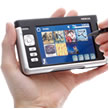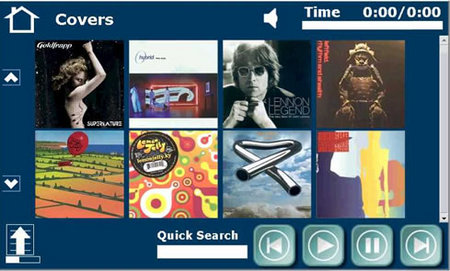Device Profile: Pinnacle Audio Athenaeum music server
Oct 11, 2006 — by LinuxDevices Staff — from the LinuxDevices Archive — 1 views UK-based Pinnacle Audio used embedded Linux to build an ultra-high-fidelity, hard-drive-based music server capable of storing roughly 9,000 CDs, with lossless compression. The Athenaeum comes with a Linux-powered Nokia 770 Internet Tablet, which serves as its remote control, and it features a 24-bit, 96kHz… digital-to-analog converter.
UK-based Pinnacle Audio used embedded Linux to build an ultra-high-fidelity, hard-drive-based music server capable of storing roughly 9,000 CDs, with lossless compression. The Athenaeum comes with a Linux-powered Nokia 770 Internet Tablet, which serves as its remote control, and it features a 24-bit, 96kHz… digital-to-analog converter.


An included Nokia 770 tablet serves as the Athenaeum's remote control
 Drive bays |
digg this story |
The Athenaeum features four hot-swappable hard drive bays, with modules available from 160GB to 750GB. The drives can be added one at a time, as needed, and are “the quietest available,” Pinnacle says — suggesting they might be sourced from Seagate, which has long specialized in A/V-oriented drives. The drives can be configured in a RAID 1 array, to ensure data safekeeping.
The Athenaeum has a front-panel information display. However, its primary interface is written in AJAX (asynchronous javascript and XML-RPC) and runs on the device's embedded webserver. Thus, the device is intended to be controlled from a laptop, PC, PDA, mobile phone, Internet tablet, or other device with a web browser capable of rendering AJAX pages.
The Athenaeum comes standard with Nokia's Linux-based 770, a general-purpose Internet tablet with an Opera browser supporting modern web standards such as AJAX.

Nokia 770's remote interface
Alternatively, the Athenaeum can be controlled through proprietary whole-house audio control systems from Crestron or AMX, with the addition of available software modules.
The Athenaeum automatically adds CDs to its library upon insertion, acquiring metadata and cover art from affiliate web services. Metadata is cached in a SQL database, for rapid search, even with large music collections, the company says.
The Athenaeum's default format is FLAC lossless, which reduces CD file size by about fifty percent. The device also supports uncompressed WAV files, MP3s at bitrates from 128kbps to 320kbps, and Ogg Vorbis, at compression levels from four to 10.
Support for additional codecs, including those not yet developed, will be available through firmware upgrades, Pinnacle promises.
Unlike the Russound SMS3, which is capable of delivering four separate analog audio streams, the Athenaeum has only a single, high-quality stereo analog out. However, Pinnacle plans to add media extenders that will enable network-based music distribution to remote amplifiers.
A less expensive hard-drive-based media server with two internal, non-hot-swappable hard drives is also planned.
Compared to a Media Center PC based on Microsoft Windows, the Athenaeum uses much less power — about 40 Watts in standby mode, compared to 160 Watts, Pinnacle says. At full utilization, the device is said to draw 100 Watts.
Additionally, the Athenaeum's embedded processor is passively cooled, for lower noise, while the case's cooling fans are throttled by a sophisticated onboard sensor system, according to the company.
Additional touted features include:
- Ability to import existing digital music collections, gleaning meta-data from ID3 tags and filenames
- Windows filesharing
- Compatible with iPods and other portable music players
- Automatic CD ripping when CDs are inserted
- 24-bit, 96kHz DAC
- 22Hz-22kHz,-0.4,-0.4dB claimed frequency response
- 104dB (A-weighted) (D/A)100.4dB (A-weighted) (A/D) claimed dynamic range
- 0.002 percent claimed THD (total harmonic distortion)
- Control system (Crestron, AMX) library modules provided
- Serial port and API allow control system integration
- 17 x 17.7 x 5.3 inches (430 x 450 x 135mm)
What's under the hood?
The Athenaeum is based on a Via C7 processor, clocked at 1GHz. It has 512MB of RAM, and boots from 128MB of CompactFlash, which is plugged into an IDE socket. About 19MB of the boot drive is used for OS and operational software, according to Andrew Gatt, technical director.
The Athenaeum offers standard PC I/O interfaces, such as Ethernet, USB, and a serial port. A built-in WiFi interface is optional.
Audio I/O includes line-level out, as well as both S/PDIF and coaxial digital line outs.
On the software side, the Athenaeum is based on the latest available 2.4-series Linux kernel. Gatt notes, “We have plans to move to 2.6, but have held off so far. We have a highly tuned 2.4 kernel that performs very well.”
Other interesting open source software includes busybox, JACK (Jack audio connection kit), and SQLite. Gatt explains, “Busybox for its size, JACK for its superb handling of realtime audio, and sqlite for its incredible size and performance.”
The Linux port, and all additional software, were created internally, by Pinnacle Audio's software programmers, using Linux development machines, Gatt said.
Gatt says he has long advocated Linux, and would recommend it to anyone. “The support community is such that any problem from small to large can be tackled quickly and efficiently. Anything you don't like, change it! It's something that open source will always have over proprietary operating systems.”
Asked about challenges involved in using Linux to create the Athenaeum, Gatt replied, “One of the first hurdles was getting a hand-tuned OS running. Although there are many solutions out there, we wanted to be very specific with what was in and out of our OS. Once this was done, the main challenge was real-time audio. With quite a low performance CPU doing lots of tasks at once we had to ensure that the audio threads and processes were running at the highest possible priority, and that no other tasks could hinder their execution. JACK helped enormously with this.”
Gatt predicts that Linux will be “a large contender” in the embedded market, “if we can keep the support community going, and keep the technology improving.”
Availability
The Athenaeum appears to be available now, at an unspecified price.
Pinnacle has published pricing for music digitization services, however, which run five pence each for CDs, 8GBP per record side, and 4GBP per cassette tape, including “digital remastering.”
This article was originally published on LinuxDevices.com and has been donated to the open source community by QuinStreet Inc. Please visit LinuxToday.com for up-to-date news and articles about Linux and open source.